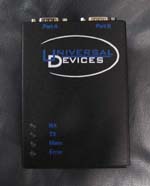TECHAV.com
home automation - home theater - pc integration
Universal Devices Insteon ISY-26
Posted 11/04/2007
The ISY-26 is an ethernet-based device designed to allow easy programming and control of Insteon devices. The user programs events, triggers, etc. that will run without requiring a PC running 24/7.
To install, simply plug the ISY-26 into your network, and plug the included Insteon PLM into an available electrical outlet. The cable to hook the ISY-26 to the PLM is included. The ISY-26 will receive an IP address automatically from your router (or other DHCP server).
The ISY-26's PC interface requires Java. Simply install the latest version of Java, and if UPNP is enabled on your PC a 'My Lighting' icon will appear in your Network Places. I am able to login to the interface using a Vista Business PC running IE7 and a Windows XP PC running IE6 with no issues.
First comment I have to make is that tech support at UDI is beyond exceptional. The few questions I've had with the unit were resolved very quickly over the phone. Any comments or concerns posted to their forums are answered quickly and professionally. UDI is also very open to user input - many current features of the ISY-26 were originally suggestions posted to their forums.
Within a few hours, I was able to add my 60+ device Insteon network into the ISY-26 and re-create all my scenes and links. I was also able to reprogram my Insteon RemoteLincs fairly quickly.
I did experience a couple instances where the included PLM would stop communicating during heavy use scenarios, such as the initial programming. Simply unplugging the PLM and plugging it back in after a few seconds fixed the issue. This is an issue with the Insteon PLM, however, and not the ISY-26. SmartHome is reportedly working on an updated firmware to correct the issue. Day-to-day use has not caused any lockups for me, so it appears to only be an initial configuration annoyance with the ISY-26.
Once you get a hang of the interface, it's simply the easiest way I've found to create and delete links and scenes with Insteon. Replacing devices is also a snap with a 'Replace' function built right into the interface.
Finding a good location for the included PLM is key to a stable network. The PLM is used by the ISY-26 to communicate with Insteon over the powerline. PCs and other electronic devices can cause interference - if you have communications issues with devices on your Insteon network, purchase a FilterLinc and install on any suspect devices plugged in close to the PLM. Plugging in an Insteon AccessPoint to the back of the PLM also helps improve signal reliability.
Setting up events on the ISY-26 is a breeze. Want to turn on your front door lights 30 minutes after sunset? No problem. Want to turn them off at 10pm? Easy. Timers are also easy to setup. Do the kids have a habit of leaving on the closet or bathroom lights? Simply have the ISY-26 automatically turn them off after a set period of time. I also use triggers to turn on entire rooms with a simple double-tap of a switch. To turn my entire bathrooms on or off (lights, vents, etc.), I simply double-tap the switch instead of single-tap. Far more sophisticated programs can be created as well, these are just some quick and easy examples.
Basic X10 functionality is built-in to the ISY-26. I'm personally using a WGL V572A X10 RF transceiver located on the same circuit as my ISY-26 / PLM to receive X10 signals from inexpensive X10 motion sensors and keychain remotes. While there is a couple second processing time (typical X10 RF delay, to the powerline, to the PLM, to the ISY-26, then processed there), it works very well for my needs. They X10 keychain remotes are especially useful to me until smaller Insteon remotes are released. Also - if X10 powerline signals are reliable for you, this allows you to integrate an X10 IR receiver into your system for additional remote control options.
The ISY-26 also integrates with the popular Elk M1 automation panel. My Elk is still in the box, however, so I was unable to test this functionality.
In the several months I've been using it, I've been extremely happy with my ISY-26. I've had pretty much no issues - even the beta firmware, which adds many features, is very, very solid. I can't wait to find out what other devices UDI has in store for the automation market.
Links


